
Bugs Bunny is a fictional character created in the late 1930s at Warner Bros. Cartoons and voiced originally by Mel Blanc. Bugs is best known for his featured roles in the Looney Tunes and Merrie Melodies series of animated short films, produced by Warner Bros. Earlier iterations of the character first appeared in Ben Hardaway's Porky's Hare Hunt (1938) and subsequent shorts before Bugs's definitive characterization debuted in Tex Avery's A Wild Hare (1940). Bob Givens, Chuck Jones, and Robert McKimson are credited for defining Bugs's design.
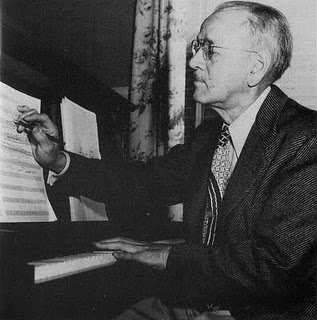
Carl William Stalling was an American composer, voice actor and arranger for music in animated films. He is most closely associated with the Looney Tunes and Merrie Melodies shorts produced by Warner Bros., where he averaged one complete score each week, for 22 years.

Merrie Melodies is an American animated comedy short film series distributed by Warner Bros. Pictures. It is the companion series to Looney Tunes, and featured many of the same characters. It originally ran from August 2, 1931, to September 20, 1969, during the golden age of American animation, though it was revived in 1979, with new shorts sporadically released until June 13, 1997. Originally, Merrie Melodies placed emphasis on one-shot color films in comparison to the black-and-white Looney Tunes films. After Bugs Bunny became the breakout character of Merrie Melodies and Looney Tunes transitioned to color production in the early 1940s, the two series gradually lost their distinctions and shorts were assigned to each series randomly.

Rhapsody Rabbit is a 1946 American animated comedy short film in the Merrie Melodies series, directed by Friz Freleng and featuring Bugs Bunny. The movie was originally released to theaters by Warner Bros. Pictures on November 9, 1946. This short is a follow-up of sorts to Freleng's 1941 Academy Award-nominated Rhapsody in Rivets, which featured the "Hungarian Rhapsody No. 2" by Franz Liszt. The "instrument" used to perform the "Hungarian Rhapsody" in Rhapsody in Rivets is a skyscraper under construction, while this short features Bugs playing the piece at a piano while being pestered by a mouse.

Looney Tunes Golden Collection: Volume 1 is a DVD box set that was released by Warner Home Video on October 28, 2003. The first release of the Looney Tunes Golden Collection DVD series, it contains 56 Looney Tunes and Merrie Melodies cartoons and numerous supplements. The set won the Classic Award at the Parents' Choice Awards.

Hair-Raising Hare is a Warner Bros. Merrie Melodies cartoon, released on May 25, 1946. It was directed by Chuck Jones and written by Tedd Pierce. It stars Bugs Bunny and features the first appearance of Chuck Jones' orange monster character "Gossamer".
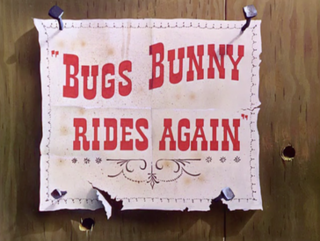
Bugs Bunny Rides Again is a 1948 Merrie Melodies animated short directed by Friz Freleng. The short was released on June 12, 1948, and stars Bugs Bunny and Yosemite Sam.

Herr Meets Hare is a 1945 anti-Nazi Merrie Melodies cartoon directed by Friz Freleng. The short was released on January 13, 1945, and features Bugs Bunny. This short, released not long before the collapse of the Third Reich, was the penultimate wartime themed cartoon from Warner Bros. being released just under four months before Victory in Europe Day.

Looney Tunes Golden Collection: Volume 4 is a DVD box set that was released by Warner Home Video on November 14, 2006.

The Bugs Bunny/Road Runner Movie is a 1979 American animated comedy package film directed by Chuck Jones, consisting of a compilation of classic Looney Tunes/Merrie Melodies shorts and newly animated bridging sequences hosted by Bugs Bunny. The bridging sequences, which had been produced in 1978, show Bugs at his home, which is cantilevered over a carrot-juice waterfall. The film was released to celebrate the 40th anniversary of Bugs Bunny.

Looney Tunes Golden Collection: Volume 5 is a Looney Tunes collection on DVD. Following the pattern of one release each year of the previous volumes, it was released on October 30, 2007.
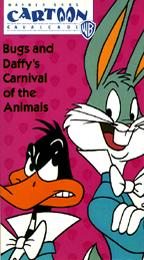
Bugs and Daffy's Carnival of the Animals is a 1976 live action/animated television special featuring the Looney Tunes characters Bugs Bunny and Daffy Duck and directed by Chuck Jones.
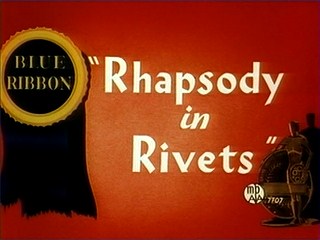
Rhapsody in Rivets is a 1941 Warner Bros. Merrie Melodies cartoon directed by Friz Freleng. The short was released on December 6, 1941.
Bugs vs. Daffy: Battle of the Music Video Stars is a 1988 animated television special broadcast on CBS on October 21, 1988. The story revolves around two competing television stations that show music videos from classic Looney Tunes shorts. The stations are hosted by Bugs Bunny (WABBIT) and Daffy Duck (KPUT). This special aired after This Is America, Charlie Brown: The Mayflower Voyagers.
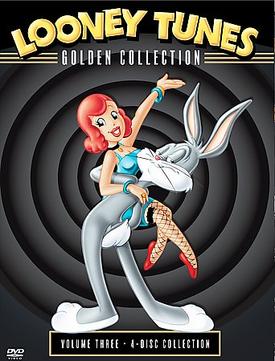
Looney Tunes Golden Collection: Volume 3 is a DVD box set from Warner Home Video that was released on October 25, 2005. It contains 60 Looney Tunes and Merrie Melodies theatrical short subject cartoons, nine documentaries, 32 commentary tracks from animators and historians, 11 "vintage treasures from the vault", and 11 music-only or music-and-sound-effects audio tracks.

Looney Tunes Golden Collection: Volume 2 is a DVD box set that was released by Warner Home Video on November 2, 2004. It contains 60 Looney Tunes and Merrie Melodies cartoons and numerous supplements.
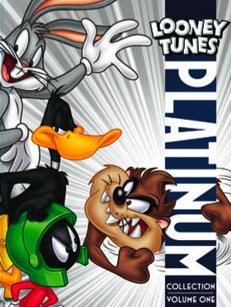
Looney Tunes Platinum Collection: Volume 1 is a Blu-ray Disc and DVD box set by Warner Home Video. It was released on November 15, 2011. It contains 50 Looney Tunes and Merrie Melodies cartoons and numerous supplements. A DVD version of the box set was released on July 3, 2012, but contained no extras.

Looney Tunes Platinum Collection: Volume 2 is a Blu-ray and DVD box set by Warner Home Video released on October 16, 2012. It contains 50 Looney Tunes and Merrie Melodies cartoons and numerous supplements. Disc 3 is exclusive to the Blu-ray version of the set. Unlike Volume 1, which was released in a digibook, Volume 2 was released in a standard 1 movie case. This release was followed by Looney Tunes Platinum Collection: Volume 3

Looney Tunes Platinum Collection: Volume 3 is a Blu-ray and DVD release by Warner Home Video. It contains 50 Looney Tunes and Merrie Melodies cartoons and numerous supplements. It was released on Blu-ray on August 12, 2014, and was released on DVD on November 4, 2014.
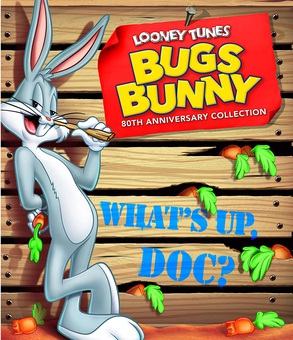
Looney Tunes: Bugs Bunny 80th Anniversary Collection is a Blu-ray Disc box-set released by Warner Bros. Home Entertainment on December 1, 2020. It contains 60 Looney Tunes and Merrie Melodies shorts starring Bugs Bunny and numerous bonus features and supplementary content. The set's packaging includes a slip book, a booklet, and a collectible Bugs Bunny Funko! POP doll.



















